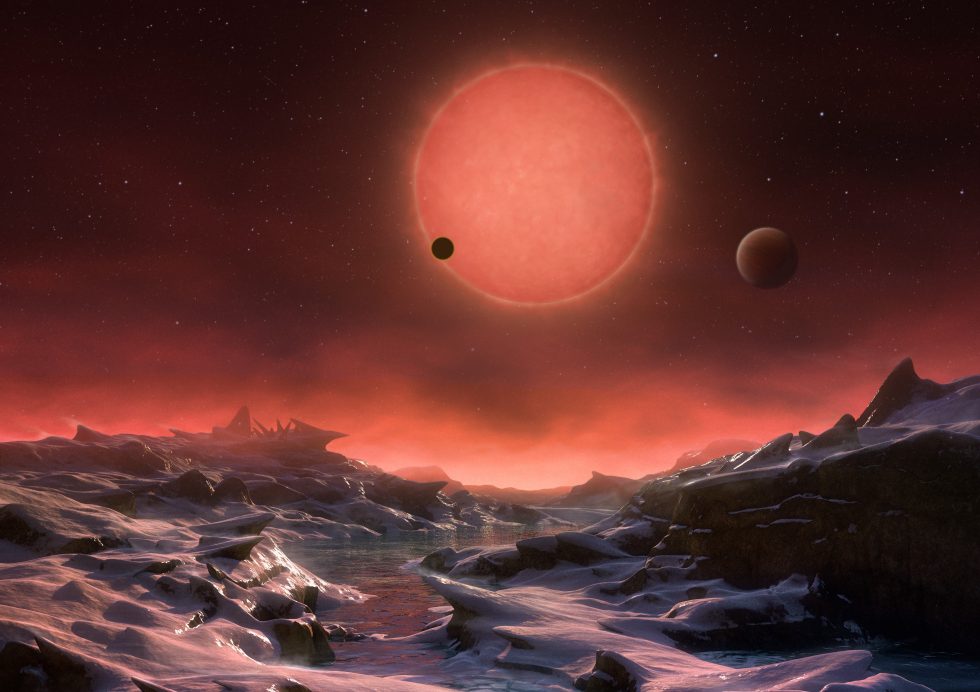
The star is only about the size of Jupiter and much colder and redder than the Sun. Its luminosity is far less than 1 percent that of our star—so faint that, although the "ultracool" dwarf star called TRAPPIST-1 lies less than 40 light-years from Earth, it can only be seen via relatively powerful telescopes.
Yet it is a star worth looking for. Astronomers using a 60cm telescope designed especially to study such stars, and any planets around them, have found this system to contain some of the most habitable exoplanets discovered to date. As European astronomers looked at TRAPPIST-1 from September through December of last year, they discovered slight, periodic dimming that indicates the presence of three worlds which are close to or inside the system's habitable zone. All have radii of between 1.05 and 1.17 that of Earth's radius.
According to the observations published Monday in the journal Nature, the two inner planets orbit the star every 1.51 days and 2.42 days. The innermost planet, TRAPPIST-1b, likely receives about four times the solar radiation from its star than does Earth, and astronomers estimate its surface temperature is probably closer to the higher end of a range between 11 degrees and 127 degrees Celsius. The next planet, TRAPPIST-1c, receives a little more than two times the solar radiation as does Earth and has a surface temperature likely between -30 degrees and 69 degrees Celsius. The researchers speculate these worlds are likely tidally locked and, therefore, even if they have extreme average temperatures, they may have habitable regions along the terminator or poles.
A third planet, TRAPPIST-1d, is more intriguing still. Although astronomers have fewer confirmed observations of this world, they estimate its orbital period is between 4 and 70 days, and it is quite a bit farther out, perhaps 0.146 astronomical units (the Earth-Sun distance) from its star. Nevertheless, between the star's warmth and likely presence of interior tidal heating, they speculate this world probably lies within or just beyond the habitable zone of the star.
-
This artist’s impression shows an imagined view of the three planets orbiting an ultracool dwarf star just 40 light-years from Earth.ESO/M. Kornmesser
-
These worlds have sizes and temperatures similar to those of Venus and Earth and are some of the best targets found so far in the search for life outside the Solar System.ESO/M. Kornmesser
-
This artist’s impression shows an imagined view from the surface of the outermost of the three planets.
-
This image compares the small star TRAPPIST-1 to the Sun.
-
This chart shows the naked-eye stars visible on a clear dark night in the sprawling constellation of Aquarius (The Water Carrier). The position of the faint and very red ultracool dwarf star TRAPPIST-1 is marked. Although nearby, the star is so faint it is not visible in small telescopes.ESO/IAU/Sky & Telescope
-
The TRAPPIST telescope is located in the Atacama Desert, at an altitude of 2,400meters, in Chile.Trappist/ESO
-
The 60cm telescope is devoted to the detection and characterization of planets located outside our Solar System and to the study of comets and other small bodies in our Solar System.Trappist/ESO
-
The name TRAPPIST, a beloved kind of Belgian beer, was given to the telescope to underline the Belgian origin of the project.Trappist/ESO
Much uncertainty about the nature of these three worlds remains, however, as only so much information can be deduced from the star's light. One big question concerns the masses of the three planets, which cannot be determined from existing observations. An analysis of Kepler spacecraft data found that most Earth-sized worlds in close orbit around Sun-like stars are rocky. However much less is known about early conditions of a system forming around ultracool dwarfs, and so it is not clear whether these are icy, rocky, or gassy planets.
Nonetheless the finding is significant for at least a couple of reasons. First, it provides some observational backing to the theory that small, cool stars could be reservoirs of planets. Astronomers estimate that about 15 percent of stars in the "neighborhood" around the Sun are these ultracool dwarf stars. Second, the proximity of the TRAPPIST system opens the door to observations with existing large telescopes.
"Why are we trying to detect Earth-like planets around the smallest and coolest stars in the solar neighborhood? The reason is simple: systems around these tiny stars are the only places where we can detect life on an Earth-sized exoplanet with our current technology, said Michaël Gillon, lead author of the Nature paper. "So if we want to find life elsewhere in the Universe, this is where we should start to look."
Indeed, observations with the Hubble Space Telescope could provide some initial constraints on the atmospheres of these three worlds. Then the James Webb Space Telescope, scheduled to launch in late 2018, could provide critical information about the abundance of molecules in the atmosphere, including the biologically interesting water, carbon dioxide, methane, and ozone. This information would also allow astronomers to put constraints around the surface temperatures of these worlds. Other, much larger ground-based telescopes, such as the Giant Magellan Telescope, due to come online in the 2020s, will provide further details.
Nature, 2016. DOI: 10.1038/nature17448 (About DOIs).
reader comments
148